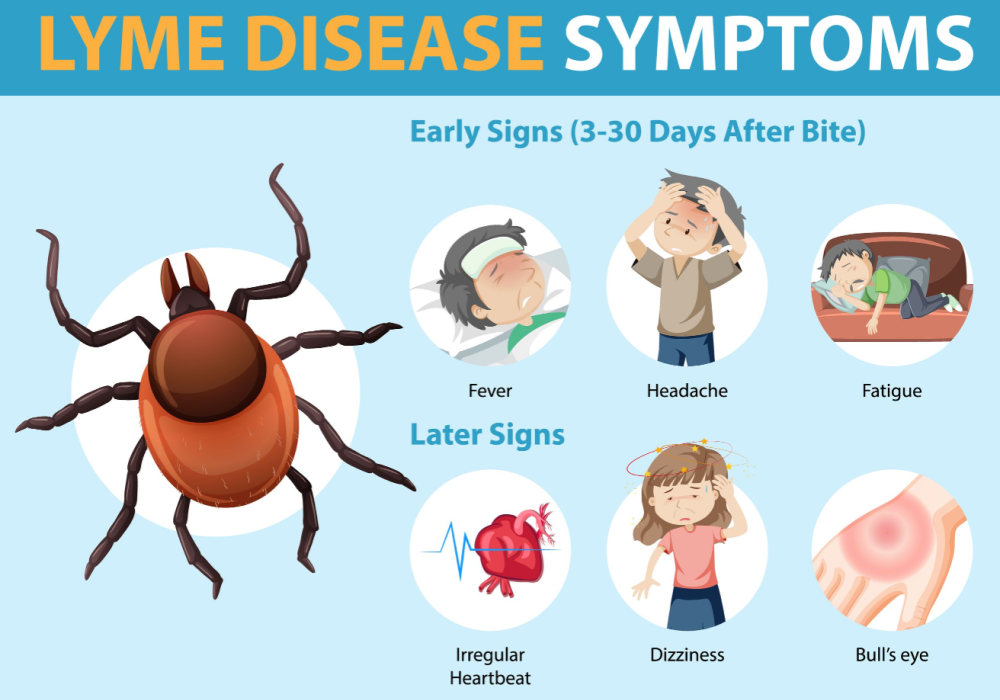The Link Between Tick Bites & Autoimmune Diseases: What You Need to Know
Medically reviewed by Adair Anderson, MS, RDN, LDN
Ticks, the small but formidable arachnids, are more than just a nuisance. They’re major vectors of diseases, with Lyme disease being the most prevalent in the United States.
And it’s not just Lyme—over the past few decades, tick populations and the diseases they carry have surged—more than doubling in the past 13 years.
These tiny creatures thrive in wooded and grassy areas, latching onto their hosts to feed and transmitting various pathogens.
What makes ticks particularly dangerous is not just their ability to spread infections like Lyme disease but their potential role in triggering autoimmune responses.
The mechanisms by which tickborne pathogens influence the immune system are complex and still being unraveled.
Growing evidence suggests infections transmitted by ticks can initiate or exacerbate autoimmune disorders in susceptible individuals, making the study of these interactions crucial for both diagnosis and treatment.
This article dissects the intricate connection between tick bites and autoimmune diseases, including the biological processes behind tickborne illnesses, the impact of these pathogens on the immune system, and advanced diagnostic tools for effective diagnosis and management.

Table of Contents
The Science of Tick Bites
The pathogenesis of tickborne illness begins when a tick attaches to its host, leading to a series of interactions that can profoundly affect human health.
Overview of Common Ticks and Their Habitats
Ticks that commonly bite humans include the black-legged tick (or deer tick), the lone star tick, and the American dog tick. These ticks are found in wooded, brushy, and grassy areas, especially in regions with high humidity. Their presence in these habitats emphasizes the importance of environmental awareness for prevention.
Pathophysiology of Tick Bites

When a tick latches onto its host, it typically remains attached for several days. The tick's mouthparts are designed to anchor securely to the host, allowing it to feed undisturbed.
As it feeds, the tick can transmit pathogens harbored in its saliva through a process known as salivary injection.
The Biological Process from Bite to Disease Transmission:
- Attachment and Feeding: Initially, the tick’s bite is usually painless, which allows it to feed undetected. During this time, the tick secretes saliva containing anesthetic properties, reducing pain and immune response at the bite site.
- Saliva Exchange: Tick saliva is not merely a feeding aid but a complex cocktail of proteins and molecules designed to modulate the host's immune response. These include anti-inflammatory and immunosuppressive agents that facilitate the tick’s feeding and enhance pathogen transmission.
- Pathogen Transmission: As the tick engorges, pathogens in its gut migrate to its salivary glands. From here, they are transmitted to the host’s bloodstream. This process can take several hours to days, which is why prompt removal of ticks is often effective in preventing disease.
- Immune Response and Potential Autoimmunity: Introducing foreign proteins (from the tick and any pathogens it carries) into the host's bloodstream can trigger an immune response. This response can become dysregulated in susceptible individuals, potentially leading to autoimmune reactions.
Tickborne Diseases and Autoimmune Responses
Tickborne diseases, while diverse in their presentation, pose significant health risks and have potential long-term consequences, including the triggering of autoimmune responses.
Direct Impact of Tickborne Pathogens

Ticks carry many pathogens that cause diseases in humans. The most well-known and widespread of these include:
- Lyme Disease: Caused by the bacterium Borrelia burgdorferi, it’s the most commonly reported tickborne illness in the United States and Europe.
- Babesiosis: This malaria-like illness is caused by the protozoa Babesia, which infects and destroys red blood cells.
- Anaplasmosis: Caused by Anaplasma phagocytophilum, this disease affects white blood cells and can lead to severe flu-like symptoms.
- Ehrlichiosis: Similar to anaplasmosis but caused by different species of Ehrlichia bacteria, it also targets white blood cells and can cause severe illness if left untreated.
These pathogens can incite autoimmune responses by directly affecting the immune system’s ability to distinguish between foreign invaders and the body’s own cells.
The inflammation and immune dysregulation triggered can pave the way for autoimmune diseases.
Borrelia Burgdorferi and The Human Body
Once it enters the human body, Borrelia burgdorferi implements various survival mechanisms, damaging the host’s immunity.
The tickborne bacteria is a potent antigen— once it enters the human body, it can undergo changes in gene expression to adapt to its new environment.
Additionally, by binding to many different host tissue components and adhering to extravascular tissue, the bacteria can colonize various tissues in the body.
Initially, when a tick carrying Borrelia bites a human, the bacterium enters the skin and can spread to different body parts through the bloodstream.

During its journey, Borrelia burgdorferi has several strategies to evade the immune system, including altering its surface proteins, which confounds immune detection and response.1
As the bacteria disseminate, they can sequester in remote areas of the body, like the joints, skin, and the nervous system.
This ability to hide from the immune system, combined with its antigenic variation, allows the bacteria to persist long-term, potentially causing chronic symptoms.
This can lead to disabling post-treatment syndromes that persist even after the bacterial infection is treated, such as the development of autoimmune disorders.1
Mechanisms Linking Tickborne Diseases to Autoimmune Diseases
There are several factors that may be responsible for a tickborne pathogen triggering an autoimmune reaction.
Immune System Response to Tickborne Pathogens
Like with other threats, the body's initial reaction to a tickborne pathogen is to mobilize the immune system to attack the invader.
This response is necessary to eliminate the pathogen but can become problematic if excessive or misdirected.
The chronic inflammation triggered by ongoing or unresolved infections can alter the normal functioning of the immune system, potentially leading to autoimmunity.

Molecular Mimicry and Other Pathways
Molecular mimicry is one of the fundamental mechanisms through which tickborne infections may lead to autoimmune disease.
Here, while targeting the pathogens, the immune system also mistakenly attacks the body’s own cells.
This occurs because certain protein sequences on the pathogen resemble the body's own protein sequences. The immune system's failure to distinguish between the two can lead to an immune response against the body’s own tissues.
Other damaging responses include:
- Bystander Activation: Infection-induced tissue damage can release sequestered antigens otherwise hidden from the immune system. The immune system may react aggressively when exposed to these antigens, leading to further tissue damage.
- Epitope Spreading: Initially, the immune response targets specific pathogen antigens, but over time, it may begin to target a broader range of antigens, including those of the host, escalating into an autoimmune condition.
Symptoms and Diagnosis of Tickborne Autoimmune Diseases
The challenge of diagnosing tickborne diseases is compounded when these infections lead to or coexist with autoimmune disorders.
Recognizing the overlap of symptoms between tickborne diseases and autoimmune disorders can provide insights into their complex interplay and guide more effective diagnostic strategies.
Common Symptoms
Lyme disease can manifest through diverse symptoms impacting the skin, heart, joints, brain, and eyes. These symptoms often overlap with those seen in autoimmune diseases, complicating the diagnostic process.
Common overlapping symptoms include:
- Fatigue: A pervasive sense of tiredness not relieved by rest, commonly reported in both conditions.
- Joint Pain and Swelling: This condition is especially prevalent in conditions such as Lyme arthritis, resembling rheumatoid arthritis or other inflammatory joint diseases.
- Muscle Aches and Weakness: Frequently observed in both tickborne illnesses and autoimmune diseases, adding to the patient’s discomfort and mobility issues.
- Neurological Complaints: These may include headaches, dizziness, and, in some cases, more severe complications such as facial palsy or neuropathy.
- Fever and Chills: Often among the initial signs of an infection but also seen in autoimmune responses as the body reacts to perceived internal threats.
- Skin Rashes: The classic bull’s-eye rash (erythema migrans) is specific to Lyme disease, but other nonspecific rashes are common in various autoimmune disorders.

These symptoms can be seen in autoimmune conditions like rheumatoid arthritis (RA), systemic sclerosis (SSc), systemic lupus erythematosus (SLE), and dermatomyositis (DM).3
The similarity in symptoms leads to significant challenges in differential diagnosis.
Symptoms like joint pain and fatigue are nonspecific and can be attributed to a wide range of diseases, making it difficult to pinpoint their cause without comprehensive testing.
This is especially true in cases of chronic Lyme, where patients will develop such chronic, nonspecific symptoms, similar to autoimmune, neuromuscular, or other bodily disorders.3
Challenges in Differential Diagnosis
Differential diagnosis requires careful consideration of your clinical history, symptomatology, and exposure risks. The overlapping nature of symptoms often necessitates a range of diagnostic tests to rule out other conditions.
This process can be time-consuming and frustrating for both patients and healthcare providers, underlining the need for more specific and sensitive diagnostic tools.
Advanced Diagnostic Strategies
Accurate and early diagnosis is especially critical when dealing with tickborne illness, as symptoms can become severe if left untreated.
Timely identification of the underlying causes of symptoms can lead to more effective treatment strategies, potentially reducing the risk of chronic complications.
The Tickborne Diseases Test + Lyme Autoimmune Panel

Vibrant’s Tickborne Diseases Test and Tickborne Autoimmunity Panel provide advanced tools for detecting tickborne illness and associated autoimmune conditions.
The Tickborne Diseases Test detects a broad range of antibodies and exposure to multiple pathogens simultaneously.
Vibrant’s Tickborne panel provides protein microarray antigen and PCR detection of Lyme disease, TBRF, and co-infections with tickborne diseases like Anaplasma, Babesia, Borrelia, Bartonella, Ehrlichia, and Rickettsia species.
The panel’s dual approach—testing for antibodies (indirect) and DNA (direct) — provides the most comprehensive Lyme and co-infection detection.
The test uses a first-of-its-kind customizable multiplex protein microarray and chemiluminescence detection to test antibody reactions to pathogens.
Protein microarray technology allows you to access the full scope of antigen reactions rather than relying on only a limited number.
This allows for more comprehensive and accurate Lyme disease testing.
The Lyme Autoimmune panel provides targeted information regarding autoimmune conditions associated with tick bites.
The test detects 11 antibodies against specific antigens related to Lyme disease that are known to trigger or mimic autoimmune conditions, focusing on arthritis, carditis, and neuroborreliosis.
Testing for Lyme-linked autoimmune responses is crucial for those currently diagnosed with Lyme disease or post-treatment to identify the presence of or risk for developing autoimmune conditions.
Understanding the root cause of symptoms is vital for receiving appropriate treatment and preventing further damage.
.png?width=800&height=533&name=Tickborne%20Diseases%20%20Advanced%20Detection%20Technology%20(800%20x%201200%20px).png)
Benefits of Vibrant tickborne testing include:
- Comprehensive Screening: Vibrant's tests screen for a wide array of tickborne pathogens and antibodies associated with autoimmune responses to provide a detailed view of the ailment.
- High Sensitivity and Specificity: Utilizing cutting-edge technology, these panels ensure high accuracy in detecting both current infections and indications of autoimmune processes.
- Diagnostic Clarity: Differentiating between symptoms caused by Lyme disease and other conditions, such as rheumatoid arthritis or aging, is essential for enabling proper treatment.
- Early Detection: Testing for both tickborne pathogens and antibodies linked to autoimmunity can prevent the progression of tickborne illness and its severe autoimmune manifestations.
By combining these two panels, you can position yourself for comprehensive diagnosis, better outcomes, and more precise management of these challenging conditions.
Tickborne Illness, Autoimmunity, and Health

Ticks, small as they are, carry pathogens that can cause significant health disruptions, affecting various body systems. From neurological complications to joint inflammation and heart issues, the potential impact is vast and varied.
Recognizing and addressing tickborne illnesses promptly enhances the effectiveness of treatment and significantly reduces the risk of developing chronic conditions that can arise from delayed diagnosis.
Advanced tools like the Tickborne Diseases Test and the Lyme Autoimmune Panel are pivotal in this comprehensive management strategy.
By enabling precise and early diagnosis, these tests ensure that treatment can be as targeted and effective as possible, protecting against the more severe consequences of tickborne diseases.
The fight against tickborne illnesses is a multidimensional battle that requires awareness, prompt action, and an integrated approach to healthcare.
As we advance our understanding and improve our diagnostic and treatment strategies, we enhance our ability to protect and promote the health of individuals exposed to these challenging diseases.
Want to learn more about the multifaceted effects of tickborne illness?
Read these next:
Misdiagnosis and Delayed Treatment: The Consequences of Chronic Lyme Disease
Research Spotlight: Protein Microarray for Comprehensive Tickborne Testing
References:
- Coburn J, Garcia B, Hu LT, Jewett MW, Kraiczy P, Norris SJ, Skare J. Lyme Disease Pathogenesis. Curr Issues Mol Biol. 2021;42:473-518. doi: 10.21775/cimb.042.473. Epub 2020 Dec 23. PMID: 33353871; PMCID: PMC8046170.
- Published in Volume 130, Issue 5 on May 1, 2020
J Clin Invest. 2020;130(5):2148–2151. https://doi.org/10.1172/JCI138062.
© 2020 American Society for Clinical Investigation - Doskaliuk, B., Zimba, O. Borrelia burgdorferi and autoimmune mechanisms: implications for mimicry, misdiagnosis, and mismanagement in Lyme disease and autoimmune disorders. Rheumatol Int (2024). https://doi.org/10.1007/s00296-024-05580-x
 By
By




